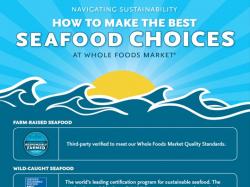Whole Foods Market & Scientific Organizations Simplify Seafood Sustainability Ratings
June 4, 2014 | 3 min to read

AUSTIN, Texas – Brought together through four years of partnership with Whole Foods Market, the Monterey Bay Aquarium Seafood Watch® program and The Safina Center (formerly Blue Ocean Institute) will now use Monterey Bay Aquarium’s science-based criteria and methodology for rating the sustainability of wild-caught seafood, offering consumers consistent recommendations from trustworthy nonprofit conservation organizations.
Sharing research responsibilities and utilizing the same criteria and methodology also means that Monterey Bay Aquarium (MBA) and The Safina Center (TSC) have a greater capacity to evaluate a larger number of species and fisheries. The more species that are rated, the more seafood choices retailers like Whole Foods Market can offer.
Increasing the availability of “Best Choice” (green) or “Good Alternative” (yellow) options in the seafood case has a positive effect on our oceans and fishing communities. Fishermen from fisheries that earn these ratings through responsible practices have an avenue into the sustainable seafood marketplace. In this way, the ratings program provides an economic incentive to fish responsibly and helps shift the seafood industry toward greater sustainability.
“Whole Foods Market has excelled as a leader in seafood sustainability because partners like MBA and TSC provide us with the latest science on the most abundant species and the best managed fisheries,” said David Pilat, global seafood buyer for Whole Foods Market. “They share our commitment to the highest standards and continual improvement, so this collaboration will streamline all our efforts to keep driving change in the industry.”
The methodology, developed by MBA with input from TSC and other stakeholders, evaluates the same main criteria as Safina Center’s previous ratings, including the abundance of fish populations, the impacts of fishing, and how well the process of fishing is controlled and managed. Other critical factors evaluated include whether the fishing method targets only the intended species, or if any other species are caught in the process (known as bycatch), as well as the impact of fishing gear on the habitat. Assessments are robust, peer-reviewed and transparent.
“Streamlining our research with the Monterey Bay Aquarium helps us know the sustainability status of more species of fish. Whole Foods Market turns that knowledge into buying power and market influence,” said Carl Safina, founding president of The Safina Center. “There’s a real impact on the water when retailers like Whole Foods Market source responsibly caught seafood, creating an economic reward for fisheries to improve their ratings.”
Combining the scientific expertise of MBA and TSC with the consumer insight of Whole Foods Market also helps the organizations prioritize research on the most impactful seafood issues. The company provides input on regional favorites, seasonal items and household staples to help determine which species to evaluate, ultimately giving consumers a greater number of choices and driving demand for seafood coming from responsible fisheries.
“Our collaboration with The Safina Center will maximize our ability to provide retailers like Whole Foods Market with robust and consistent seafood recommendations from a diversity of sources, ultimately rewarding better performing fisheries,” said Jennifer Dianto Kemmerly, Seafood Watch director at Monterey Bay Aquarium.
Whole Foods Market is fully transparent about the sustainability status of the seafood offered in stores. The company’s policy is to source as much seafood certified by the Marine Stewardship Council (MSC) as possible. When MSC-certified options are not available, customers use the sustainability ratings from MBA and The Safina Center to choose green- and yellow-rated options. Whole Foods Market removed all red-rated seafood from stores in 2012. Red ratings indicate that the species is overfished, poorly managed, or caught in ways cause harm to habitats or other wildlife.
Critical to delivering on the promise of sustainable seafood is Whole Foods Market’s strict traceability requirements, which ensure that all items in the seafood case – both wild-caught and farmed – can be traced through the supply chain. In every step between the water and the store, Whole Foods Market suppliers and distribution centers log more than 20 fields of information about every piece of seafood. Additionally, the Marine Stewardship Council certification requires rigorous chain of custody requirements. These comprehensive systems provide full traceability so customers can be assured that all seafood offered at Whole Foods Market meets the stated standards.
Source: Whole Foods Market
